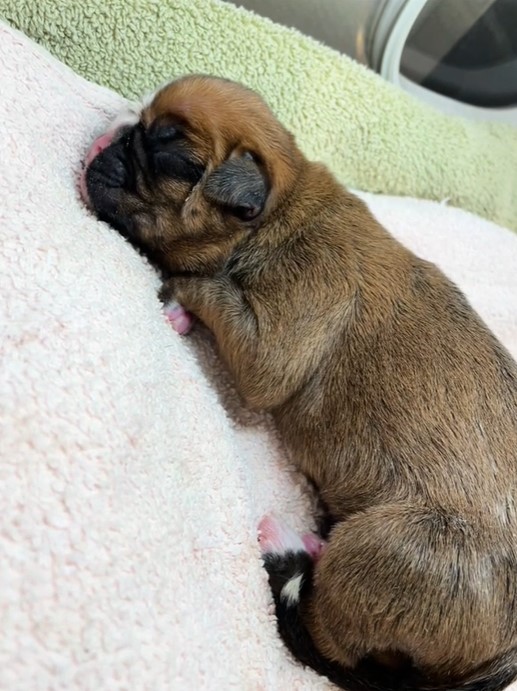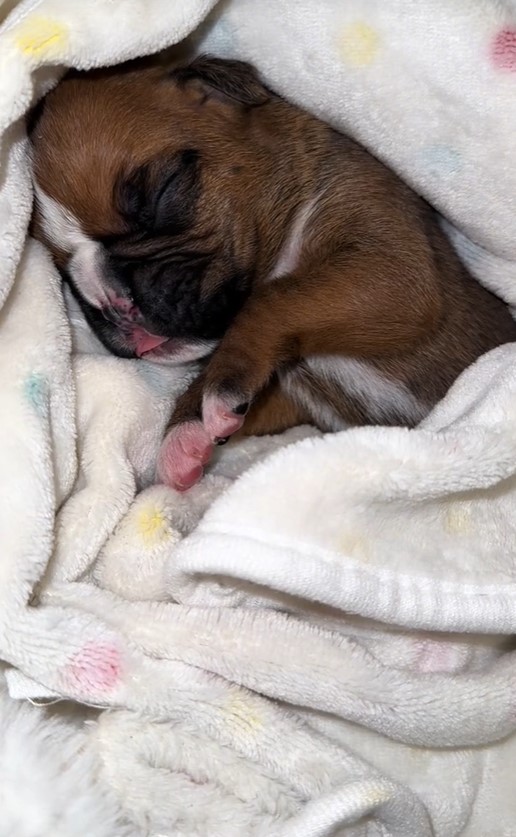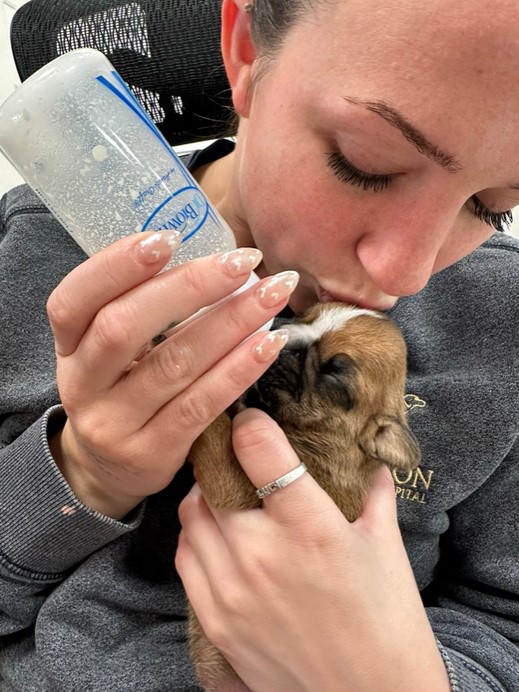Being different doesn’t mean that you are any less worthy. Everybody deserves a chance, no matter their imperfections.
This little Boxer puppy was born different from the rest of his litter, and the owner didn’t think she deserved a chance to live.
She was born with a cleft palate, which meant the breeder wouldn’t be able to sell or show her, and thus, she was invaluable to him.
Fortunately, the nurses who work in the veterinary clinic believed that she didn’t deserve to be euthanized because of a treatable condition, so they decided to step in and save the little pup.
Born Different, Not Less
 Source: TikTok
Source: TikTok
In February 2024, someone brought a pregnant Boxer dog to the Stockton Veterinary Hospital in New Jersey that needed surgery.
Puppies were born, but one happened to be a little bit different from others. She was actually born with a cleft palate, which is a relatively common condition in dogs.
According to the American College of Veterinary Surgeons, a cleft palate is “an opening between the mouth and the nose that happens when the tissue separating the two cavities do not grow together properly.”
Since this puppy could not be sold or shown, the breeder wanted the veterinarians to euthanize her.
 Source: TikTok
Source: TikTok
One of the hospitals’ certified veterinary technicians, Nicole Morvant, simply couldn’t bear to let this tiny puppy get euthanized, especially when there was a whole life ahead of her.

“Her cleft palate is quite big, but she was able to eat from a bottle in the beginning (as opposed to tube feeding) every three to four hours, and she’s now eating regular soft food a few times a day. She will need surgery to correct it when she’s bigger, which we will do at our hospital in the northeast,” Morvant told Newsweek.
Alive And Thriving

The tiny puppy – who is yet to be named – is living at home in New Jersey with Morvant, where she gets all the love, care, and cuddles she deserves.
Taking care of a puppy with a cleft palate is challenging, but luckily, nurse Morvant knows how to keep her healthy and happy.
They had to bottle-feed her formula at first, but now that she is a bit older, they started to mix puppy kibble and puppy wet food with some water and gelatin.
“A lot of people are saying that keeping her alive is cruel and selfish, but I would argue getting rid of the puppy because they need a little bit more care, a little bit more patience, a little bit more time, a little bit more work, a little bit more love, is cruel and selfish thing to do,” Morvant said in one of the videos she posted on TikTok.
She keeps growing, learning, and showing people that her life is worth living despite being a tiny bit different.
She’s an adorable little puppy who loves to snuggle and nap or be a little bit sassy. Recently she found her voice and is not afraid to use it.
“All in all, the amount of love she’s received on social media is overwhelming and she now has an entire army behind her cheering her on,” Morvant said.

She is a little fighter who definitely has a lot to show the world.
For updates on this little princess, please follow Nicole Morvant on TikTok.
If you’re a dog owner, you know the joy of having a furry companion by your side. But when it comes to bath time, things can get a bit tricky. Keeping your pup clean is essential, but how often should you be lathering them up? Finding the right balance between cleanliness and skin health is key to a happy and healthy dog.
You want your four-legged friend to be fresh and clean, but over-bathing can strip their skin of natural oils, leading to dryness and irritation. On the flip side, not bathing them frequently enough can result in a smelly pooch. So, how do you strike the perfect balance? Understanding your dog’s breed, coat type, and lifestyle factors can help you determine the ideal bathing schedule to keep them looking and feeling their best.
Importance of Bathing Dog Regularly
Ensuring your furry friend is bathed regularly is essential for maintaining their overall health and happiness. Regular baths help to eliminate dirt, odors, and potential skin irritants, keeping your dog clean and comfortable.
By bathing your dog routinely, you can prevent skin issues such as infections, hotspots, and dermatitis. A clean coat reduces the likelihood of matting and tangling, making grooming more manageable and ensuring your dog’s coat remains healthy and shiny.
Regular baths also help in managing shedding by removing loose fur and debris. This can be especially beneficial for individuals prone to allergies, as it reduces the presence of allergens in your home environment.
Bathing your dog regularly provides an opportunity to examine their skin for any abnormalities, parasites, or signs of discomfort. Early detection of these issues can lead to timely treatment and prevent more significant problems down the line.
Moreover, the bonding experience during bath time can strengthen the relationship between you and your canine companion. It’s a time for interaction and care that your dog will appreciate, creating a positive association with grooming activities.
Regular baths are a simple yet crucial aspect of dog care that contributes to their well-being and strengthens your bond. Make bath time a regular part of your pet care routine to keep your furry friend healthy, happy, and looking their best.
Factors to Consider when Deciding Bathing Frequency
When deciding how often to bathe your dog, there are several factors to take into account to ensure you maintain a healthy balance that keeps your furry friend clean and happy.
1. Coat Type:
Consider your dog’s coat type when determining bathing frequency. Dogs with oily coats may need baths more frequently to prevent a buildup of oils that can lead to skin issues. On the other hand, dogs with dry skin may require less frequent baths to avoid stripping their skin of essential oils.
2. Activity Level:
Take into consideration your dog’s activity level. More active dogs that spend a lot of time outdoors may need more frequent baths to wash away dirt, mud, and debris. Indoor dogs or those with less activity may not need baths as often, as they are less exposed to external dirt.
3. Skin Conditions:
If your dog has any skin conditions, such as allergies or dermatitis, their bathing frequency may need to be adjusted accordingly. Consult your veterinarian for guidance on how often to bathe a dog with specific skin issues to prevent exacerbating any existing conditions.
4. Odor and Dirt:
Pay attention to how your dog smells and looks. If they start to develop a noticeable odor or their coat becomes visibly dirty, it’s a good indication that they may need a bath. Regularly checking for odors and dirt can help you determine the optimal bathing schedule for your dog.
5. Bathing Products:
The type of shampoo and grooming products you use can also impact how often you should bathe your dog. Using gentle, veterinarian-recommended products can help maintain your dog’s skin health and coat condition, allowing you to space out baths accordingly.
By considering these factors and observing your dog’s specific needs, you can determine the ideal bathing frequency to keep your furry companion clean, comfortable, and healthy.
General Guidelines for Bathing Dogs
When it comes to bathing your dog, there are general guidelines to help you maintain their cleanliness and skin health without overdoing it.
- Coat Type: Dogs with different coat types require varying bathing frequencies. Short-haired breeds like Beagles can usually be bathed every 6-8 weeks, while long-haired breeds like Maltese may benefit from a bath every 4 weeks.
- Activity Level: If your dog is more active and loves outdoor adventures, they might need more frequent baths to clean off dirt and debris. Indoor dogs may require fewer baths.
- Skin Conditions: Dogs with skin conditions like allergies or dermatitis might need special medicated baths as prescribed by a veterinarian. These baths should follow the vet’s instructions to avoid skin irritation.
- Odor and Dirt: If you notice a strong odor or dirt buildup on your dog, it’s a sign that they need a bath. Regular grooming can help keep your pup fresh between baths.
- Bathing Products: Use dog-specific shampoos that are gentle on your pup’s skin and coat. Avoid using human shampoos as they may cause skin irritation.
- Frequency: In general, most dogs benefit from a bath every 4-6 weeks. However, always consider your dog’s individual needs and adjust the frequency based on the factors mentioned above.
Keep these guidelines in mind to establish a bathing routine that keeps your furry friend clean, comfortable, and healthy.
Signs Your Dog Needs a Bath
When it comes to figuring out when your furry companion needs a bath, paying attention to certain signs is key. Here are some indicators that it’s time to give your pup a good scrub:
- Odor: If your dog has a noticeable smell, it might be time for a bath. Keep an “odor check” to ensure your pet stays fresh.
- Dirty Coat: A visibly dirty or muddy coat is a clear sign that it’s bath time for your furry friend.
- Skin Irritation: Watch out for any signs of skin irritation, redness, or itching, as these can indicate the need for a bath to soothe the skin.
- Greasy Fur: Dogs with oily or greasy fur may benefit from more frequent baths to keep their coat clean and healthy.
- Excessive Shedding: If your dog is shedding more than usual, a bath can help remove loose fur and prevent excessive shedding.
- Outdoor Adventures: After outdoor adventures or romps in the dirt, it’s a good idea to wash off any dirt and debris to keep your dog’s skin and coat in top shape.
- Frequency: While the ideal bathing frequency varies based on factors like coat type, activity level, and skin conditions, these signs can help you determine when your dog needs a bath.
Tips for Bathing Your Dog Properly
When it comes to bathing your dog, there are some essential tips to keep in mind to ensure a proper and effective bathing routine. Follow these tips to make the experience pleasant for both you and your furry friend:
- Use Lukewarm Water: Start by using lukewarm water to wet your dog’s coat thoroughly. Avoid hot water as it can be uncomfortable for your dog.
- Choose the Right Shampoo: Select a gentle dog shampoo that is specifically formulated for your dog’s coat type. Avoid using human shampoos as they can be too harsh for your pup’s skin.
- Protect the Eyes and Ears: Be careful when applying shampoo around your dog’s eyes and ears. Use a tearless shampoo for the face and a damp cloth to clean around the ears.
- Thoroughly Rinse: Make sure to rinse your dog’s coat thoroughly after shampooing to remove all traces of soap. Any leftover shampoo can cause skin irritation.
- Dry Thoroughly: Use a towel to dry your dog’s coat gently after the bath. If your dog allows it, you can also use a hairdryer on the lowest setting, keeping it a safe distance away to prevent burns.
- Brush Their Coat: After drying, brush your dog’s coat to prevent tangles and mats. Regular brushing can also help distribute natural oils and keep the coat healthy.
- Reward and Praise: Always reward your dog with treats and praise after a bath. This positive reinforcement can make bath time a more enjoyable experience for your furry companion.
By following these simple tips, you can ensure that bath time is a positive experience for both you and your dog, keeping their coat clean and healthy.
Conclusion
Remember, finding the right bathing schedule for your furry friend is key to maintaining their cleanliness and skin health. Over-bathing can strip their coat of natural oils, while infrequent baths may lead to odor and skin issues. Factors like coat type, activity level, and skin conditions play a role in determining how often your dog should be bathed. By following the guidelines provided and using essential tips like using lukewarm water, gentle drying, and choosing the right shampoo, you can ensure a positive bathing experience for your dog. Regular baths not only keep your dog clean and healthy but also strengthen the bond between you and your pet. So, find the right balance, enjoy bath time with your pup, and keep them feeling fresh and happy!
Frequently Asked Questions
How often should I bathe my dog?
The ideal bathing frequency for dogs varies based on factors like coat type, activity level, skin conditions, and dirt accumulation. Generally, dogs with normal skin can be bathed every 4-6 weeks.
What are the risks of over-bathing my dog?
Over-bathing can strip the natural oils from your dog’s skin, leading to dryness, itchiness, and potential skin issues like dermatitis. It can also disrupt the skin’s natural pH balance.
What are the consequences of infrequent bathing for my dog?
Infrequent bathing can result in a buildup of dirt, oil, and bacteria on your dog’s coat, leading to a dull appearance, unpleasant odor, and potential skin infections.
How can I make bath time a positive experience for my dog?
To make bath time enjoyable for your dog, use lukewarm water, a gentle shampoo suitable for their skin type, protect their eyes and ears, rinse thoroughly, dry gently, brush their coat afterwards, and reward and praise them for good behavior.
What are the essential tips for bathing my dog properly?
Essential tips for bathing your dog include using lukewarm water, choosing a mild shampoo, protecting their eyes and ears, rinsing thoroughly, drying gently, brushing the coat, and rewarding and praising the dog after the bath.
[no_toc]

Hey there, I’m Janet Brooks, a dog-loving student from California. I’m all about helping pups in need, especially those without homes. Me and my awesome friends work together to give shelter and love to stray dogs. Oh, and I also write blogs about dogs to share helpful info.